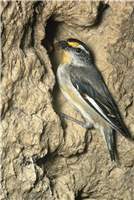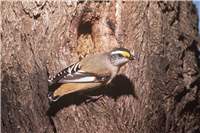Family
Pardalotidae
Genus
Pardalotus
Species
striatus
Threats/Control Methods - Regional
The food and shelter of the Striated Pardalotes is under threat from land clearing for urban development and from garden landscaping that excludes any mature native growth. Extremely wet and cold winters limit the availability of insect infestations, leading to mass deaths of these little birds.
Threats/Control Methods - Local
Domestic Cats (Felis catus) and Dogs (Canis familiaris) threaten their survival, particularly in the spring and summer breeding season months.
Local/Urban Actions
Pardalotes will also use nest boxes successfully for breeding, placed between 1-9 meters up. An entrance diameter of 4cm and an inside diameter of 13cm is recommended in a horizontal nest box with a 30cm tunnel entrance. Ensure the nest box is visible and pest birds such as Common Mynas (Acridotheres tristis ) or Starlings (Sternus vulgaris) are not using it. Pet owners are encouraged to keep their cats and dogs contained, especially in the breeding season from September to February, as they are very susceptible to attack in their low-lying nests.
Common Names
Striated Pardalote, Pickwick, Wittachew, Allied Diamondbird, Allied Pardalote, Chestnut-rumped Pardalote, Chuck-a-chuck, Stripe-crowned Pardalote
Distinguishing Features
This is a small, stubby, brightly coloured bird of 9.5-11.5cm in size. It has a bright yellow face and throat, an olive-grey back and a distinctive bright red spot on the side of the wing feathers. It has a white eyebrow and a white-streaked head with a white stripe on the wings. The female's colours are slightly less bright and young birds are similar to the adults, except they are paler, particularly in the face and throat.
Survey Techniques
Call and visual identification.
Species Call
Clear, sharp and musical 'witta-witta' or a contact call of short trills.
Similar Species
The Striate Pardalote is found across most of Australia with the exception of the driest, most arid areas.
Distribution
The Striated Pardalote is found across most of Australia with the exception of the driest, most arid areas.
Country of Origin
Australia.
Conservation (Pet/Pest) Status - Regional
Overall, the population numbers seem fairly stable, with a slight decline (COG).
Conservation (Pet/Pest) Status - National
Secure, not listed under the EPBC Act 1999.
LSCCES Population
This species was found in highest numbers at BMt and the ANBG. Medium abundances were recorded at ANU, NMA, Turner and Civic West.
Associated vegetation community
The Striated Pardalote will survive in diverse habitats, from wet eucalypt forest to semi-desert river corridors. In this region of Australia, it prefers eucalypt forest and woodland.
Limiting Resources
This species prefers thick, large areas of vegetation and will not be found in very immature tree stands, preferring older eucalypts with a large canopy.
Breeding
Striated Pardalotes form breeding pairs or small groups of up to six birds. A pair or group will share the responsibilities of raising 3-5 young each season. They build a cup or dome shaped nest of grass and bark -shreds in either hollow trees or in burrows. In the Canberra region, they can have an early breeding season, but most activity takes place from early September, peaking in October and November and ending by February.
Behaviour
These Pardalotes feed in large groups, maintaining communication with one another with a trill-like contact call. They guard their nests rigorously, dancing protectively to ward off any other Pardalotes.
Functional Group
Food Species
This species eats a variety of insects and their larvae, particularly lerp and scale insects, picking them off the leaves of eucalypts tree canopies.
Predators
As tree hollows are not usually readily available, the species builds its nest on the ground. This leaves them susceptible to attacks by Cats (Felis catus) and Dogs (Canis familiaris).
Interesting Fact
Pardalotes are easiest to spot in the breeding season, as they fly to and from their ground burrow without worrying about being seen by humans or other animals.
References - (reader suitability of references, P=Primary teachers, S=Secondary students, T=Tertiary students and researchers)
Books:Delgale, J. 1997. Attracting Birds to your Garden in Australia. New Holland Publishing. NSW. P, S, T
Longmore, W. 1991. Honeyeaters and their Allies of Australia. CollinsAngus&Robertson Publishers Australia. NSW. P, S, T
Morcombe, M. 2000. Field Guide to Australian Birds. Steve Parish Publishing. Archerfield. Australia P, S, T
Pizzey, G. 2000. The Graham Pizzey & Frank Knight Field Guide to the Birds of Australia. Angus & Robertson, Sydney. P, S, T
Veerman, P. 2003. Canberra Birds: A report on the first 21 years of the garden bird survey. Philip Veerman and Canberra Ornithologists Group. Canberra. S, T
Internet: Birds in Backyards. 2006. [online]. Available at:http://www.birdsinbackyards.net P, S, T
Canberra Ornithological Group (COG). 2004. Birds of Canberra Gardens. COG and the ACT Department of Urban Services. [online]. Available at:http://garden.canberrabirds.org.au/ P, S, T
Online Publications:Nix, H. and Cunningham, R. 2006. Birds of the Lower Sullivans Creek Catchment, Canberra ACT. Prepared for the Life in the Suburbs project using data from the Lower Sullivans Creek Catchment Ecological Survey (LSCCES). Australian National University. Canberra. [online]. Available at: http://www.lifeinthesuburbs.com.au/category.php?id=65 S, T
Olsen, P. et al. 2005. The State of Australia's Birds 2006: Invasive Species. Supplement to Wingspan 16:4. Birds Australia. [online]. Available at http://www.birdsaustralia.com.au/soab/SOAB2006.pdf S, T
Taws, N. et al. 2001. Bringing Birds Back: A Glovebox Guide for Bird Identification and Habitat Restoration in ACT and SE NSW. Greening Australia ACT and SE NSW Inc. [online]. Available at: http://www.greeningaustralia.org.au/NR/rdonlyres/D8B0DB48-7B51-419D-9C93-A48FB26E8CD3/3888/G12446BBBreprint1.pdf P, S, T


 Top
Top Top
Top